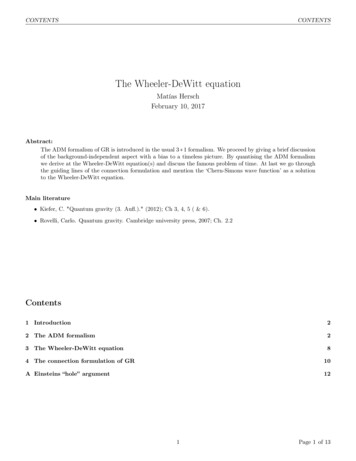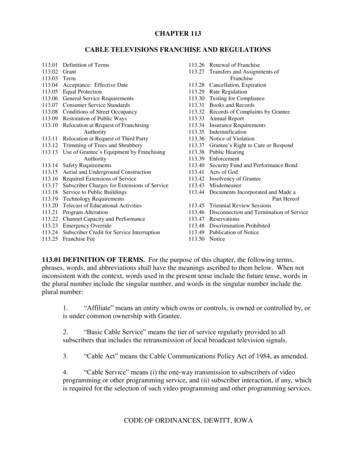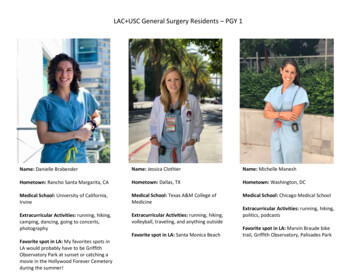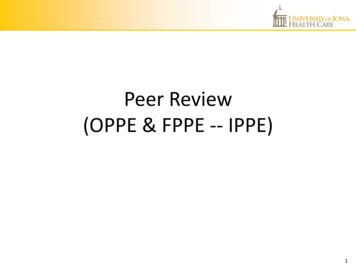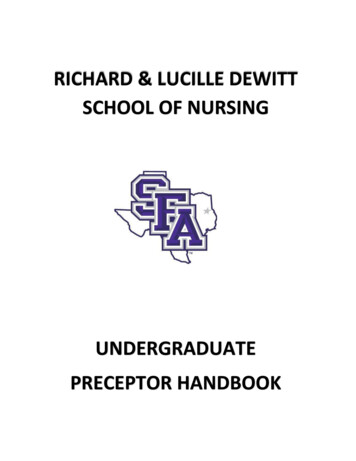
Transcription
RICHARD & LUCILLE DEWITTSCHOOL OF NURSINGUNDERGRADUATEPRECEPTOR HANDBOOK
DISCLAIMERThis handbook is a general information publication only. It is not intended to nor does it contain allregulations that relate to nursing students. The provisions of this handbook do not constitute a contract,expressed or implied, between any applicant, student or faculty member and Stephen F. Austin StateUniversity or the Richard and Lucille DeWitt School of Nursing. Stephen F. Austin State Universityreserves the right to withdraw courses at any time, to change fees or tuition, calendar, curriculum,degree requirements, graduation procedures, and any other requirements affecting students. Changeswill become effective whenever the proper authorities so determine and will apply to both prospectivestudents and those already enrolled.ContentsOverview of the DeWitt School of Nursing . 4What is a Preceptor? . 7Course Documents . 10Helpful Tips for Precepting All SFA Students . 10NURS 3630: Care of the Adult Client. 11NURS 3431: Care of Women and Children I . 15NURS 3232: Care in Promotion of Mental Wellness. 19NURS 4606: Care of Adult Client with Complex Health Needs . 22NURS 4407: Care of Women and Children II . 26NURS 4208: Care of Clients with Complex Mental Health Needs . 30NURS 4431: Care of Community Populations . 33NURS 4432: Leadership/Coordination of Nursing . 36NURS 4233: Capstone . 39NURS 4440: RN-BSN Community. 43NURS 4441: RN-BSN Leadership . 46Preceptor Agreement and Application for Exemption Program for Clinical Preceptors and Their Children . 49Faculty Responsibilities: . 50Preceptor Responsibilities: . 51Agency Responsibilities: . 52Student Responsibilities: . 52Policies . 54Student Evaluation of Preceptor and Clinical Site . 55
3Dear Preceptor:Thank you for serving as preceptor for a BSN student from Stephen F. Austin State University DeWittSchool of Nursing. The clinical experiences the student will obtain in your clinical area are of criticalimportance to the successful learning in the program. Without your help, these students would not havethese valuable experiences!The student will work closely with you, learning from your advice and example. You are the key tosuccessful learning experiences in the clinical setting. The clinical instructor is responsible for clinicalsupervision. The preceptor and instructor collaborate in providing clinical instruction and evaluation.Instructor supervision may include site visits, preceptor consultation, and/or one to one clinicalexperience with faculty.This Preceptor Handbook provides a brief description of the Undergraduate Program at SFASU. Itoutlines the responsibilities of the student, the preceptor, and the School of Nursing. Students areengaged in didactic coursework, along with clinical experiences. The student with whom you work canprovide you with a list of topics covered during this and previous semesters to assist you in determiningyour expectations of the student. You will also find course specific information for the particular courseyou are precepting. Student Clinical Evaluation forms to be completed by you are provided.If you agree to be a preceptor, you will need to complete the Preceptor Agreement, a formal contract,which establishes the legal parameters between you and the SFASU DeWitt School of Nursing. Weappreciate your contribution to our program and your critical role in the clinical education of ourstudents. Thank you again for your service to the DeWitt School of Nursing, our students, and thenursing profession.Sincerely,DeWitt School of Nursing Faculty
4Overview of the DeWitt School of NursingVisionEmpower nursing professionals to impact healthcare and serve in a changing world.MissionOur mission is to provide students a foundation for success as nurses who are ethical, competent criticalthinkers by providing an educational environment that promotes holistic health care in an educationalcommunity dedicated to teaching, research, creativity and service.Core ValuesIntellectual and Creative EngagementSON faculty encourage the student to investigate the health needs of a changing society and to think increative ways to provide holistic health care to culturally diverse populations and engage the nursingprofession.A Diverse Student BodyThe unique individual student is engaged and valued as a partner in the diverse learning community andin the nursing profession.Teaching and LearningThe facilitation of transformative learning experiences will inspire innovation and excellence, andfosters life-long learning in the nursing profession.Faculty ExcellenceFaculty will seek new ways to provide a collaborative, respectful, inclusive learning experience andserve as positive examples of nursing professionals.PartnershipsThe SON will demonstrate integrity and facilitate trust with community partners in the nursingprofession in meeting the needs of culturally diverse populations.The Nursing Metaparadigm1. NursingNursing graduates at every level are expected to meet the academic and ethical standards of theprofession. Nursing is a profession of arts and science dedicated to facilitating holistic care to allpersons.2. PersonThe individual, family, group, or community that engages with the nurse in the healthcare deliverysystem.3. Health“A state of complete physical, mental, and social wellbeing, not merely the absence of disease orinfirmity.” (World Health Organization, 2019)4. Environment
5The setting in which the student learns and practices nursing.Curricular Philosophical FrameworkThe philosophical framework for the DeWitt School of Nursing is multifaceted reflecting thedynamic focus of nursing education and the nursing profession. The primary supportive philosophy andtheory are Benner’s Novice to Expert and Watson’s Theory of Human Caring. There are manyadditional influences; however, these provide the primary underpinning for the curricular frameworkaddressing both the art and science of nursing.Benner’s Novice to ExpertBenner identifies the five levels of nursing experience based on the Dreyfus model of skillacquisition. Though this philosophy is targeted to the professional nurse, it is applicable tomatriculation in nursing education. The five levels include novice, advanced beginner, competent,proficient, and expert (Benner, 1982). The first level, novice, describes a beginner with no experiencein a situation in which they are to perform tasks (Benner, 1982). The advanced beginner demonstratesmarginally acceptable performance while level three, competent, describes the individual who isconsciously aware of goals and plans based on abstract and analytic thought. The fourth level,proficient, is one who is able to perceive situations as whole rather than segmented parts. The final levelis the expert. The expert no longer relies solely on analytical principle, but is able to demonstrate deepermeaning and insight (Benner, 1982).Watson’s Theory of Human CaringCaring is a fundamental tenet of nursing practice. Watson’s Theory of Human Caring iscentered on the caring process defined as “caritas processes” (Watson, 2010). The caritas processincludes: practicing kindness and equanimity, being authentically present, cultivating one’s own self,developing and sustaining a caring relationship, engaging in caring practices, genuine teaching-learningexperiences, creating a healing environment, assisting with basic needs from a holistic perspective, andbeing open-minded (Watson, 2010). The major assumption of this theory relates to the moralcommitment and caring consciousness of the nurse valuing human dignity, wholeness, and healing.Nursing CurriculaThe nursing curricula in the DeWitt School of Nursing is presented in a format from simple tocomplex concepts addressing the metaparadigm of nursing, person, health, and environment. Thecognitive and psychomotor domains of learning are firmly rooted in evidence-based practice. Eachlevel also focuses on the caring nature of nursing targeting the affective domain of learning. Throughthis concerted effort, graduates of DeWitt School of Nursing are prepared to meet the challengesassociated with dynamic healthcare needs of a diverse population in an ever-changing world.
6Undergraduate End of Program Student Learning Outcomes1. Apply knowledge of the physical, social, and behavioral sciences in the provision of nursing carebased on theory and evidence based practice.2. Deliver nursing care within an established legal and ethical parameters in collaboration with clientsand members of the interdisciplinary health care team3. Provide holistic nursing care to clients while respecting individual and cultural diversity.4. Demonstrate effective leadership that fosters independent thinking, use of informatics, andcollaborative communication in the management of nursing care.5. Assume responsibility and accountability for quality improvement and delivery of safe and effectivenursing care.6. Serve as an advocate for clients and for the profession of nursing.7. Value continuing competence, growth, and development in the profession of nursing.
7What is a Preceptor?(Adapted from Carol Athey, MA, MSN, RN, CNOR and Laura Logan MSN, RN)TeacherCoachCheerleaderEvaluatorAdvocateRole ModelEssential Responsibilities Orient the preceptee to the nursing unit and facilitate the learning experience. Guide and supervise the preceptee during the clinical experience. Teach/reinforce skills and previous learning. Serve as a role model. Work closely with nursing faculty to identify education gaps and learning opportunities.Beginning the Shift Acknowledge the preceptee’s presence. Talk about what is happening today. Introduce the preceptee to staff and patients. Give clear directions and voice expectations.Throughout the Shift Discuss the chain of command. Practice role model behavior and be positive. Help preceptee to learn time management.Tips for Giving Directions Do not assume the preceptee is knowledgeable about a situation. Find out what they knowbefore you begin. Encourage them to clarify your instructions and reassure them every question is a goodquestion. People will not always admit they do not understand the instructions so ask them forclarification and comprehension. Explain the “why” when giving directions as it will help them comprehend the instruction.Guide the Preceptee Provide one-on-one guidance when demonstrating nursing skills and techniques. Supervise clinical practice at the bedside. Offer positive reinforcement for skills well done and keep negatives objective. Remember practice is needed to master a skill. Teach new skills and/or reinforce learning Serve as a role model“Reality Shock”Many preceptees experience “Reality Shock” defined as: when the preceptee realizes that the actual jobis different than the one they thought it would be. This conflict arises when ethical, moral, professionalor cultural beliefs conflict with the beliefs held by allied health care staff and/or the institution. Workissues cause anxiety.
84 Phases of Reality Shock1. Honeymoon Phase – Nursing through “rose colored glasses”2. The Shock Phase – situation that causes anger, disillusionment, or embarrassment3. Recovery Phase – preceptee is able to perceive reality in both a negative and positive aspect.4. Resolution Phase – preceptee feels he or she “fits in”Prepare Critical ThinkersCritical Thinking Nurse Asks why Is open to possibilities Views events to learn Uses intuition Notes patterns and trends Seeks adviceNon-Critical Thinking Nurse Preserves status quo Accepts norm Does not connect events and knowledge Accepts the obvious Solves problems alone and does not seek adviceQuestions to Promote Critical Thinking What do these lab results mean to you? How will you prioritize care today? What alternative measures would work for this problem? What else could be causing your patient’s symptoms? How will you evaluate the outcome of that intervention? Help me understand your thinking on this problem? Help me understand how you came to this conclusion. You appeared to freeze during that situation. What were you thinking during that time?Validating CompetencyCompetency can be validated by the preceptee’s actual performance in a variety of patient-caresituations and as the preceptee demonstrates use of clinical knowledge, skills and behaviors accordingto facility policies and procedures and well developed professional standards.Performance Rating Scale1. Satisfactory2. Needs Improvement3. UnsatisfactorySatisfactory PerformanceThe preceptee consistently: Functions with minimal guidance. Performs nursing care safely. Integrates knowledge with patient care skills. Initiates new learning opportunities. Applies nursing knowledge appropriate to the nursing unit.Needs ImprovementThe preceptee:
Usually functions with moderate guidance. Usually performs nursing care safely. Requires some assistance integrating knowledge with patient care skills. Recognizes the need for new learning activities but needs direction. Usually applies nursing knowledge appropriate to the nursing unit.UnsatisfactoryThe preceptee: Functions only with direct supervision. Usually performs nursing care safely but with difficulty. Requires continual assistance to integrate knowledge with patient care skills. Does not recognize new learning opportunities. Requires detailed instruction to apply nursing knowledge appropriate to the nursing unit.Providing FeedbackProviding ongoing evaluation to the preceptee is essential. Daily feedback validates he/she is doingwell and what additional work is needed to progress in nursing. Daily feedback motivates learning,provides time for constructive criticism, identifies areas that need remediation and determines theeffectiveness of the learning experience. You can start by asking how the student feels that the daywent. You can use the BEER Model.BEER ModelB – Behavior: what is the preceptee doing or not doing?E – Effect: how does it hinder productivity?E – Expectation: What change do you expect to meet goal?R – Result: What happens if change does not occur?Example:Traditional: The preceptor states, “You have been late for report. This is inconsiderate and the otherstaff don’t like you coming in interrupting report.”Behavior focused: The preceptor states, “You have arrived late three times this week. Do you have aproblem in the mornings with your schedule or routine? When you are late it disrupts the flow of thereport and patient safety can be compromised. What can you do to arrive on time?”End Evaluation Find a quiet place, out of public view, and be able to avoid interruptions. Maintain a relaxed professional atmosphere. Put preceptee at ease. Discuss future needs and goals. Be sincere. Ask the preceptee how you can improve as a preceptor for future preceptees.The end evaluation assures the preceptee: The goals for the clinical experience have been met. Their own limitations of knowledge and the need to be lifelong learners is evident. They will have confidence to meet future challenges in the nursing profession.Work closely with Nursing Faculty Discuss learning opportunities with the faculty. Validate the preceptee’s learning and skills. Communicate objectively with faculty about preceptee and/or preceptor concerns.9
10Course DocumentsBelow you will find the course description, clinical expectations, clinical skills, clinicaloutcomes/objectives, and clinical evaluations of nursing student by preceptor for all of the courses withprecepted clinicals. The clinical skills listed are skills the student should seek out throughout the day.The student will need your guidance to perform these skills. The student has been instructed not to bepresent when you complete the clinical evaluation. The evaluation form and student have specificinstructions on how to return the evaluation (i.e. sealed in an envelope with your signature over theseal). Ask the student for further information. Please refer to the specific course you are precepting.Instructor contact information will be provided at the time of clinical.Helpful Tips for Precepting All SFA Students Expect active participation of the student in patient care activities. Do not allow the student toturn down a learning opportunity or performing a skill. Expect the student to take report on your assigned patients. Emphasis is placed on head to toe assessments. Don’t hesitate to ask the student if they havecompleted this aspect of patient care or ask them to perform their assessment in front of you. Feel free to discuss student performance with the clinical instructor. Never hesitate to call us orleave comments on their evaluations for us. We value your feedback, positive or negative, inorder to provide the best prepared graduate nurses possible. Encourage students to make decisions about patient care and you can critique those decisions. Expect the student to report and reassess abnormal findings. Expect students to know medications. Expect professional demeanor at all times. Actively involve students in discharge planning and patient teaching activities. Actively involve students in patient admission, transfer, and discharge procedures. Discuss your time management and patient priority strategies with students as to promotedevelopment of stronger organizational skills. Students should not be doing homework or studying for classroom activities during clinicalexperiences. When students watch a procedure being performed you can quiz them afterwards about thenurse’s responsibilities within the experience. Students shouldn’t leave a shift early unless previously approved by faculty or preceptor unlessin the case of illness or personal emergency. Students are there to learn how to become a RN. Part of that learning includes answering calllights, performance of baths, bed changes and assisting with activities of daily living. Studentsalso must learn skills beyond basic care. Don’t allow students to shrug off responsibilities. They are there to learn nursing care.Sometimes they exhibit their fears and insecurities by avoiding placing themselves inuncomfortable learning experiences. Recognize this tendency but realize learning isuncomfortable but necessary. Don’t accept the answer “I don’t know” or “I was never taught this”. If they don’t know thenthey need to tell you how they will learn it. Return them to their books and the other resourcesavailable to them on the unit such as policy and procedure manuals.
11NURS 3630: Care of the Adult ClientCourse DescriptionThis course provides 2nd semester nursing students the opportunity to apply critical thinking, nursingtheory, research, and practice to the care of adult clients. Emphasis is placed on care of the client withsimple to complex health needs in a variety of health care settings.Clinical ExpectationsAll students are expected to be prepared for the clinical experience, as well as have all necessaryclinical supplies to practice. The student is required to be prepared from the beginning of the shift toassume responsibility for complete care of the assigned client(s) (including all treatments andmedications). The only exceptions are chemotherapeutic medications for cancer and blood/ bloodproduct administration. Students must be familiar with but will not administer these medications underany circumstances. The student is expected to be knowledgeable about the client’s disease processesand therapeutic interventions--both medical and nursing. All students are required to: Demonstrate continual development of critical thinking skills, in-depth application of nursingprocess and clinical expertise. Complete clinical hours. Missed clinical hours related to illness require a note from the healthcare provider. Please, do not come to clinical with fever. Arrange conferences with the instructor to discuss progression, processes, and clinicalexperiences as needed. Exercise punctuality to all clinical and agency assignments. (see clinical attendance policy). Make up missed clinical hours at discretion and timing of instructor. If unable to make clinical times please call instructor prior to clinical time. Do not call the SFAoffice phone number, your instructor is at the clinical site. Follow the SFA SON dress code. (See SON policy No. 18) Tobacco use of any kind is prohibited during clinical. No gum chewing, eating, or drinking in client care areas. Cell phones are not permitted in clinical care areas. Ask your clinical instructor if they may bepermitted in a designated area. Do not wear perfume, cologne, aftershave when in the clinical setting. Discipline self to prohibit use of slang and expletives in the clinical setting. Submit work as directed in syllabus and on course calendar/clinical schedule. Arrive on time to appropriate area with all required supplies. Practice safe care according to the Nurse Practice Act and SFASU School of Nursing Policiesand Procedures. Notify primary nurse and the instructor in the event of an emergency or change in patientcondition. On the medical-surgical unit, verify all medications and procedures with the instructor prior togiving or performing procedures and follow-up with the instructor after completion of tasks.When attending outside clinical experiences verify all medications and procedures with theassigned preceptor prior to and follow-up with the preceptor after completion of tasks. On the medical-surgical unit, the direct supervision of the instructor is required. All procedures(IV insertion, catheter insertion, dressing changes ) are to be completed under the directsupervision of the assigned preceptor in the outside clinical experiences. Report off to primary nurse before leaving unit for break, lunch, and end of shift. Arrange for SFASU nursing student to monitor your patient at any time you will be away fromthe unit (for breaks, lunch, to see procedures )
12 Actively pursue skills and experiences with primary nurse. You should not be sitting withnothing to do or bored.Demonstrate safe medication administration in all clinical areas.Clinical SkillsIV insertionNGT insertionCentral line dressing changeMed admin eval at beginning and end of semester with IVP/IVPB/PO/SQ meds
Richard & Lucille DeWitt School of Nursing Stephen F. Austin State UniversityNURS 3630: Nursing Care of Young Adult to Elderly Clinical Evaluation of NursingStudent by PreceptorStudent NamePreceptor Name (print):Date:Preceptor Signature:Time in: -----Time out:Clinical Site:----------------Clinical Group:Directions: For each performance indicator, evaluate whether the student performed the indicator: (S) satisfactorily, (NI) needsimprovement, (U) unsatisfactorily, or (N/0) not observed for this experience.Performance IndicatorsNIuN/0CommentsStudent portrays professionalism (i.e. inuniform, attitude, with clinical tools)Student actively seeks out learningopportunities.Student accurately performs skillsrequired and implements care incollaboration with the interdisciplinaryhealth care team.Student utilizes therapeuticcommunication in all interactions withpatients and acts as a patient advocate.Student utilizes the nursing process andcritical thinking in caring for patients.Student exhibits team work by assistingstaff as needed.Student follows standard precautionsand isolation precautions.Student maintains and provides patientsafety at all times.Student safely administers medicationsfollowing the 8 rights of medicationadministration.We value you and your feedback, positive or negative, in order to provide the best prepared graduate nurses possible. The studentshould not be present when you are completing this evaluation. Please continue your comments on the back of the sheet, ifnecessary.Please feel free to contact us with ANY concerns.Please hand back to student this evaluation in the provided sealed envelope with your signature over the seal.Pass ---Rev by EPEC: Fall, 20 16Fail ---
Stephen F. Austin State UniversityRichard and Lucille DeWitt School of NursingClinical Evaluation ToolNURS 3630: Nursing Care of Young Adultto Elderly Clinical ObjectivesClinical OutcomesThe student will:A. MEMBER OF THE PROFESSION1. Adhere to policies of the SON and facility as wellas moral, legal and ethical standards of theprofession while providing nursing care to clientsand families.2. Assume responsibility and accountability forquality of nursing care.3. Identify own strengths and weaknesses and utilizefeedback for professional growth.DECIA IIIAIIIEIBIDB. PROVIDER OF PATIENT-CENTEREDCARE1. Relate applicable knowledge, concepts, andtheories to clinical practice to assess persons andfamilies with identified physical and or psychiatricproblems.2. Utilize the nursing process and critical thinking inprovision of care to individuals and families basedon analysis of available data using theoreticalknowledge in collaboration with theinterdisciplinary health care team.3. Formulate goals, develop and implement plans ofcare for individual clients with health care needsusing evidence-based practice as guidance.4. Communicate therapeutically with clientsmaintaining professional boundaries. Communicateassessment findings, facts and concepts clearly inwriting, documenting appropriately.5. Evaluate and modify the plan of care forindividual clients in collaboration with theinterdisciplinary health care team.IIADECC. PATIENT SAFETY ADVOCATE1. Maintain strict infection controlmeasures in clinical settings, adhering toisolation precautions when applicableand standard precautions for all clients.2. Safely administer medicationsaccording to the 8 rights anddemonstrate knowledge of medicationsincluding applicable indication,interactions, and side effects.3. Provide for and maintain client safetyat all times in regards to environment,mobility, transfers and use ofequipment.4. Perform skills safely and efficientlyunder supervision of a clinical instructoror RN preceptor.IIIBIIIDIIIBIIIDD. MEMBER OF THE HEALTHCARE TEAM1. Collaboration with theinterdisciplinary health care team(IDHCT) to plan and implement nursingcare to individual clients and theirfamilies.2. Identify community resources andreferrals in the provision of nursingcare.IVAIVDIIE3. Establish effective workingrelationships with clients, faculty, staff,and peers. Assist peers/staff as needed,exhibit teamwork.IIF4. Serve as an advocate for clients andfamilies with health care needs.IICIIBIIDIICIVCIVB
15NURS 3431: Care of Women and Children ICourse DescriptionThis course allows 2nd semester nursing students to apply critical thinking, nursing theory, research andpractice to issues of childbearing, childrearing and women’s health. Growth and development, healthpromotion and communication will be discussed. The role of the nurse and teaching are highlighted.Clinical Expectations1. All students are expected to be present at each clinical and are responsible for all materials presentedthere. Social and work conflicts are not excused absences - do not even ask.2. Demonstrate continual development of critical thinking skills, in-depth application of nursing process andclinical expertise.3. Complete cl
University or the Richard and Lucille DeWitt School of Nursing. Stephen F. Austin State University reserves the right to withdraw courses at any time, to change fees or tuition, calendar, curriculum, . This Preceptor Handbook provides a brief description of the Undergraduate Program at SFASU. It outlines the responsibilities of the student .



